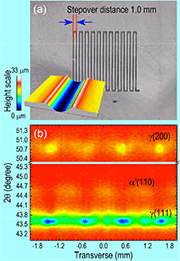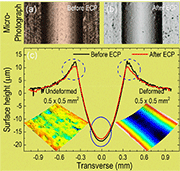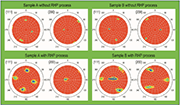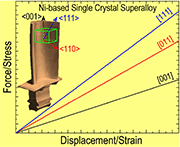E-Archive
Science Update
in Vol. 21 - March Issue - Year 2020
Robotic Hammer Peening and Its Application in Advanced Surface Enhancements

Fig. 1: In-plane distribution of the RHP-induced (a) surface plastic deformation and (b) γ-to-α phase transformation of SS304L. The inset highlights the surface heights of a single trench deformed by the RHP process along the longitudinal direction.

Fig.2: Microphotograph and surface height profiles collected from a single surface trench induced by RHP of SS304L before and after ECP process for 15 sec in A3 electrolyte (Struers) biased at 23 V. The inset images are height mappings recorded from the areas out- and in-side the trench after the ECP process.

Fig. 3: Pole figures measured by XRD from the NBSC superalloy coupons A (in the left) and B (in the right) at the areas without (on the top) and with (at the bottom) of the RHP process

Fig. 4: General anisotropic- and orientation-dependent mechanical properties of NBSC superalloys. The inset shows the typical orientation of industrial-designed turbine blades based on NBSC superalloys.
Introduction
Surface enhancements, in the community of metal-based manufacturing and/or remanufacturing, are typically referred to the mechanical cold-working processes, e.g., peening, rolling, burnishing, etc., applied on the surface of workpiece so as to enhance its fatigue life [1]. The dominant effect induced by surface enhancements on the fatigue life of metals is related to the introduction of compressive residual stresses. Beside the stressing effect, surface smoothening, hardening, and/or grain refining by surface enhancements also play important roles in extending the service lifetime of metallic components. Surface enhancement technologies have long been developed and widely employed by the industry of manufacturing based on structural metal alloys. Their developments in recent years, along with the rapid increase in additive manufacturing and ever-advancing automation and precise control systems, make advanced surface enhancements possible via dedicated process designs and/or system integrations [2].
The general physics behind cold-working in surface enhancements is associated with the generation, interaction, and/or annihilation of crystal defects that manifest themselves, in macroscale, as plastic deformations. These crystal defects include pores, microcracks, dislocations, stacking faults, twins, phase changes, etc. Their evolutions upon cold-working process give rise to accumulations of compressive residual stress, hardening, and/or grain refinements of the base materials, which in turn enhance their fatigue life, mechanical strength, anti-wear, and/or anti-corrosion properties. Various cold-working processes, e.g., robotic hammer peening (RHP), ultrasonic nanocrystal surface modification (UNSM), deep cold rolling, shot peening, laser shock peening, cavitation peening, etc., have been developed for advanced surface enhancements [3]. Amongst them, the RHP process (similar to UNSM except for the large difference in peening frequencies), without needing consumable resources such as the water in laser shock peening and cavitation peening or the media in shot peening, has the advantages of being feasibly integrated with additive manufacturing and/or other localizable surface processing techniques, e.g., laser or localized heat treatments. Such a system integration has been proposed and is currently on-going under collaborations between ARTC and IMRE (A*STAR, Singapore) for advanced surface enhancements [4].
In this communication, we report our recent research findings about RHP process of stainless steel (SS304L) and Ni-based single crystal (NBSC) superalloy coupons. The stacking fault energy, largely dependent on the elemental compositions, of SS304L (dominated by γ-phase austenite) is much lower than that of NBSC superalloys, although both are of face-centered cubic (FCC) crystal structures. As a result, the plastic deformation mechanism induced by the dynamic surface peening of SS304L is different from that of NBSC superalloys. Here, we attempt to shed light on in-plane distributions of the peening-induced plastic deformation and austenite (γ-phase) to martensite (α’-phase) transformation of SS304L as well as the peening-induced crystallographic reorientations of the NBSC superalloy. They could have important consequences when designing cold-working processes and/or system integrations via RHP for advanced surface enhancements.
Material and Methods
Commercial available SS304L and NBSC superalloy (the third generation) coupons were employed in this study. The latter ones were prepared by electrical discharging machining (EDM) and electrochemical polishing (ECP) to remove the surface deformation layers before the RHP process. The ECP process was carried out in the A3 electrolyte (Struers) at a bias of 23 V. The RHP process was performed on an ABB industrial robotic platform (IRB 6660) using a spherical tungsten carbide hammer head (FORGEfix). The diameter of the hammer head is 4 mm and its driving pressures on the SS304L and NBSC superalloy coupons are 4 and 6 bars respectively. During the process, the longitudinal feeding rate of the hammer head is 1000 mm/min while the transverse stepover distance is variable in the range of 0.1-2.0 mm.
The RHP-induced surficial plastic deformations and the material structural evolutions, including the γ-to-α’ phase transformation in SS304L and the crystallographic reorientation in the NBSC superalloys, have been characterized by using step-profilometer and X-ray diffraction (XRD) respectively. The XRD system (Bruker-D8) is equipped with a Cu-Kα X-ray tube and a general area detector, which has the great advantage of being highly sensitive to crystal phase structures. It is also highly accurate in determining the crystal orientations via pole-figure measurements.
Results and Discussion
Figure 1(a) presents a typical microphotograph taken from a RHP processed SS304L coupon with the stepover distance of 1.0 mm along the transverse direction. Figure 1(b) presents the XRD mapping collected along the transverse direction, addressing the in-plane distributions of the RHP-induced γ-to-α’ phase transformation. The inset highlights the plastic deformations surrounding a single trench formed by the RHP process along the longitudinal direction. A careful comparison between the morphology/topography and the XRD mapping reveals that the peening-induced phase transformations occurred only in the trenches rather than in the peening-induced pileup materials. With the employed RHP process parameters, a variation in the stepover distance from 2.0 to 0.1 mm reveals no surface deformations at the center between adjacent trenches until the stepover distance is reduced smaller than 0.8 mm.
Figure 2 presents the effect of RHP on corrosion of SS304L via carrying out an ECP process for 15 sec in the A3 electrolyte (Struers) biased at 23 V. The microphotographs taken before and after the ECP process of a single trench deformed by the RHP process are shown in Figs. 2(a) and 2(b) respectively. One sees that the surface areas, especially those unpeened areas beside the trench, have been smoothened by the ECP process. Figure 2(c) presents the surface height profiles collected across the RHP-induced trench before and after the ECP process and the insets show the height mappings collected after the ECP process from the areas out- (in the left) and in-side the trench (in the right), respectively. The comparisons in the height profiles outside the trench provide evidence for the ECP-induced surface smoothening; however, the comparisons in the height mappings, i.e., the inset images, reveal that the surface pitting of the ECP process has been significantly suppressed by the RHP process. Also seen is that the depth of the RHP-induced trench has been slightly reduced after the ECP process (see the circular indicators, especially the solid one, in the height profiles). These observations, together with the anti-pitting effect induced by the RHP process, suggest that the corrosion resistance of SS304L is enhanced by the RHP process, most likely due to the cold-working-induced surface smoothening. As mentioned above, the surface smoothening, and thus the anti-corrosion effect of the RHP process, is largely dependent on the processing design such as the hardness and size of the hammer head, the driving pressure, the longitudinal feeding rate, and the stepover distance, etc.
Presented in Fig. 3 are the pole figures measured by XRD, aiming at the {111} and {200} atomic planes, from the NBSC superalloy coupons at the areas with and without the RHP process. A common exhibition is that the diffraction peaks from the peened areas are significantly broadened due to the cold-working and its induced plastic deformations. Sample A shown in the left in Fig. 3 has an unintentional miscut from the surface orientation of [001] as determined from comparisons between the {111} and {200} pole figures measured at the unpeened area. After the RHP process, the misorientation angle is apparently decreased, i.e., the surface normal direction has been turned backwards in the [001] direction by the RHP process. Likewise, the surface normal of sample B is unintentionally miscut from [111] and after the RHP process, and one sees that one of the {111} diffraction peaks has been apparently turned to the surface normal direction (i.e., the center of the pole figures); both the {111} and {200} diffraction peaks have been redistributed more symmetrically about the surface normal direction. These observations indicate that the RHP process can be employed to tune the surface normal direction, beside the surface enhancements, of the NBSC superalloys.
The orientation tuning effect of the surface by the RHP process could have important consequence in manufacturing and/or remanufacturing of turbine blades based on NBSC superalloys. On one hand, as shown in Fig. 4, industrial turbine blades based on NBSC superalloys are usually fabricated in typical orientations [5]. This is because of the anisotropic and orientation-dependent mechanical properties of NBSC superalloys. On the other hand, additive manufacturing, e.g., 3D-printing, has been attracting increasing interest as a cost-effective technique for repairing individual turbine blades. In this regard, the surface enhancement process and the orientation tuning of unintentionally misoriented surfaces of additive manufactured NBSC superalloy turbine blades can be simultaneously realized by employing the RHP process.
Conclusion
The RHP process has the advantage of being feasibly integrated with additive manufacturing and/or other localizable processing techniques for advanced surface enhancements of metallic components. The plastic deformation mechanism induced by RHP in the surface layers can be tuned by process designs and/or system integrations. The process parameters play important roles in the spatial distribution of the RHP-induced plastic deformations, as well as that of the γ-to-α’ phase transformations, of austenitic stainless steel. The RHP-enhanced anti-corrosion of SS304L has been observed and attributed to the surface smoothening effect. For single crystal superalloys, the RHP process can be employed not only for surface enhancements but also for surface orientation tuning. This finding can be developed as a cost-effective process in additive manufacturing of metallic components (e.g., repair of individual turbine blades) based on single crystal superalloys.
Acknowledgement
This work is supported by A*STAR RIE2020 advanced manufacturing and engineering (AME) programmatic grant through the structural metal alloys program (SMAP, Grant no. A18B1b0061).
References
[1] S. Itoh and S. Shukla (eds.) Advanced Surface Enhancement: Proceedings of the 1st International Conference on Advanced Surface Enhancement (INCASE 2019).
[2] Y. Hu and Y. Chen, "Implementation of a Robot System for Sculptured Surface Cutting. Part 2. Finish Machining" Int. J. Adv. Manuf. Technol. Vol. 15, pp. 630-639, 1999.
[3] A. Tolga Bozdana,"On the Mechanical Surface Enhancement Techniques in Aerospace Industry―a Review of Technology" Aircr. Eng. Aerosp. Tec. Vol. 77, pp. 279-292, 2005.
[4] A similar system integration between UNSM and localized surface heating has been presented by Prof. Young Sik Pyun (Sunmoon University, Korea) at the 1st International Conference on Advanced Surface Enhancement (INCASE 2019).
[5] K. J. Bowman "Mechanical Behavior of Materials" John Wiley, 2004.
Author: Hongfei Liu (Ph. D. in Physics), Ivan Chee Kiang Tan (Ph. D. in Eng.), Yuefan Wei (Ph. D. in Eng.)



























